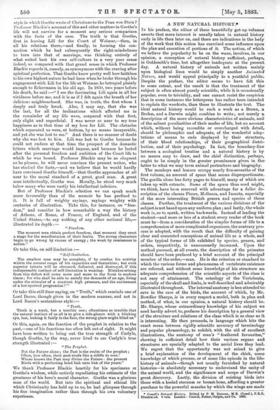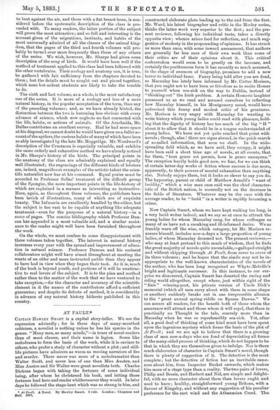A NEW NATURAL HISTORY.*
IN his preface, the editor of these beautifully got-up volumes asserts that more interest is usually taken in natural history early in life than later on, and there are indications in the body of the work that this notion has exercised some influence upon the plan and execution of portions of it. The notion, of which we believe the popularity to be on the wane, involves, in our opinion, a conception of natural history sufficient, perhaps, in Goldsmith's time, but altogether inadequate at the present day. A natural history of animals not written mainly- upon biological lines would be simply another Animated' Nature, and would appeal principally to a youthful public. Despite the preface, the editor seems to have felt this to some extent, and the result is that the treatment of the subject is often almost purely scientific, while it is occasionally popular, even to triviality, and one cannot resist the suspicion that in some instances the letterpress has rather been intended to explain the woodcuts, than these to illustrate the text. The- ideal natural history would be such a work as a Bronn, a Brehm, and a Darwin might combine to write ; not merely a. description of the more obvious characteristics of animals, andi of the salient peculiarities of their modes of life, but an account which, without being recondite or overcharged with detail, should be philosophic and adequate, of the wonderful adap- tations of means to ends displayed by their structure, of their blood relationships, of their geographical distri- bution, and of their psychology. In fact, the boundary-line between a zoological treatise and a natural history is by no means easy to draw, and the chief distinction, perhaps, ought to be simply in the greater prominence given in the latter to what we may term animal portraiture and biography.
The monkeys and lemurs occupy nearly five-sevenths of the first volume, an amount of space that seems disproportionate. The gorilla alone has forty pages to himself, many of which are- taken up with extracts. Some of the space thus used might, we think, have been reserved with advantage for a faller de- scription of the classes Pisces, Molluscs., and Insecta, especially of the more interesting British genera and species of these classes. Further, the treatment of the various divisions of the subject is not based upon any uniform plan ; and lastly, the whole work is, so to speak, written backwards. Instead of leading the student—and more or less of a student every reader of the book must be—from a consideration of the simpler forms of life to a comprehension of more complicated organisms, the contrary pro- cess is adopted, with the result that the difficulty of gaining clear and connected conceptions of animal life as a whole, and of the typical forms of life exhibited by species, genera, and orders, respectively, is unnecessarily increased. Upon the method pursued, at all events, the description of the primates should have been prefaced by a brief account of the principal member of the order,—man. He is the criterion or standard to which the various forms and phenomena of vertebrate existence are referred, and without some knowledge of his structure ant adequate comprehension of the scientific aspects of the class is not easy of attainment. The osteology of the Vertebrate, especially of the skull and limbs, is well described and admirably illustrated throughout. The internal anatomy is less attended to, save in the case of the birds, the account of which, by Mr.. Bowdler Sharpe, is in every respect a model, both in plan and method, of what, in our opinion, a natural history should be.. Mr. Sharpe, whose extraordinary knowledge of his subject we need hardly advert to, prefaces his description by a general view. of the structure and relations of the class which is as clear as it is interesting. He then proceeds, in language which hits the exact mean between rigidly scientific accuracy of terminology and popular phraseology, to exhibit, with the aid of excellent; illustrations, the anatomy of man's "feathered favourites,' showing in sufficient detail how their various organs an& structures are specially adapted to the aerial lives they lead.. We regret that the opportunity was not seized to give a brief explanation of the development of the chick, some knowledge of which process, or of some like episode in the life- history of animals—though not usually furnished by natural histories—is absolutely necessary to understand the unity of the animal world, and the significance and scope of Darwin's great discovery. Lastly, the division of existing birds into those with a keeled sternum or breast-bone, affording a greater purchase to the powerful muscles by which the wings are made • Cassell's Natural Hiktory. Edited by P. M. Demean, M.B. (Land.), F.R.S. Illustrated. 6 vole. London : Cassell, Petter.Galpin, and Co. 1882. to beat against the air, and those with a flat breastbone, is con- sidered before the systematic, description of the class is pro- ceeded with. To many readers, the latter portion of the subject will prove the most attractive ; and so full and interesting is the account given of the migrations, instincts, and habits of the most universally admired of all the classes of the animal king- dom, that the pages of the third and fourth volumes will pro- bably be turned over more frequently than those of any others of the series. We wish, however, Mr. Sharpe had given some description of the song of birds. It would have been well if the method of treatment applied to this class had been followed with the other vertebrates. Their zoology and anatomy can, it is true, be gathered with fair sufficiency from the chapters devoted to them ; but the details must be sought out and pieced together, which none but ardent students are likely to take the trouble to do.
The sixth and last volume, as a whole, is the most satisfactory one of the series. It is more of a zoology and less of a mere natural history, in the popular acceptation of the term, than any of the preceding volumes ; and, as we have already hinted, the distinction between the two is becoming less obvious with every advance of science, which now neglects no fact connected with the life, habits, or actions of animals. Of the Arachnida, Mr. Dallas contributes an excellent survey. Had he had more space at his disposal, we cannot doubt he would have given us a fuller ac- count of the spiders, the curious habits of many of which have been so ably investigated by the late Mr. Moggridge. Mr. Woodward's description of the Crustacea is especially valuable, and exhibits the same orderly and exhaustive method we have already noticed in Mr. Sharpe's history of the birds. The principal points in the anatomy of the class are admirably explained and equally well illustrated ; the engravings of the different kinds of lobsters are, indeed, magnificent examples of the artistic talent the scien- tific naturalist now has at his command. Equal praise must be accorded to Professor Soiled treatment of the difficult group of the Spongim, the more important points in the life-history of which are explained in a manner as interesting as instructive. Here, again, as throughout these volumes, the publishers have been lavish of illustrations, many of which are of exquisite beauty. The Infusoria are excellently handled by the editor, but the subject is too vast to be capable of anything like adequate treatment--even for the purposes of a natural history—in a score of pages. The concise bibliography which Professor Dun- can has appended is a most valuable aid, and a similar assist- ance to the reader might well have been furnished throughout the work.
On the whole, we must confess to some disappointment with these volumes taken together. The interest in natural history increases every year with the spread and improvement of educa- tion in natural science. Professor Duncan and his eminent collaborators might well have aimed throughout at meeting the wants of an older and more instructed public than they appear to have had in view when they began their task. As it is, much of the book is beyond youth, and portions of it will be unattrac- tive to real lovers of the subject. It is to the plan and method rather than to the matter of the work that we have ventured to take exception,—for the character and accuracy of the scientific element in it the names of the contributors afford a sufficient guarantee; and despite its defects of method, it is considerably in advance of any natural history hitherto published in this country.



































 Previous page
Previous page